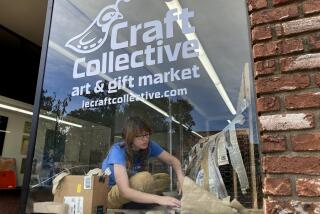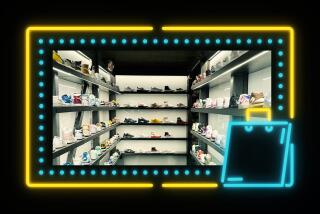Taking the pulse of Myrtle Avenue
- Share via
MONROVIA — There are no palm trees on Myrtle Avenue. This pleases Hollywood location scouts, who frequently dispatch film crews here when they need a backdrop that suggests a town in the American heartland. Indeed, in look and feel, particularly the five blocks that run through Monrovia’s Old Town district, Myrtle seems more representative of rural Iowa than metropolitan Los Angeles.
The street constitutes the center of this San Gabriel Valley town of nearly 40,000. It was named for the daughter of William Monroe, a railroad construction superintendent who, in the 1880s, flush from a sale of mules, bought 210 acres of the old Rancho Santa Anita and, with partners, started laying out a town.
“In Southern California, we are an anomaly,” said Pam Fitzpatrick, an owner of the Dollmakers’ Kattywompus toy store. “But across the country, little old towns like this, they are the heart of America.”
Fitzpatrick was speaking last Tuesday, on yet another day of financial bulletins and incessant, worried talk everywhere, much of it centered on fears that the fiscal meltdown would spread, as the oft-repeated saying went, “from Wall Street to Main Street.” A front page headline in The Times captured the zeitgeist well: “Is now a good time to panic?”
Fitzpatrick’s answer was no.
“I think it is absolutely terrifying,” the 61-year-old former telecommunications consultant said. “But the fact of the matter is you can’t fix it. If I am going to get panicky and lose sleep, what good is it going to do? Things happen in life, scary things happen. But what can you do? The only thing I can do is what I always have done. And do it better.”
In this crisis, everybody is an expert and nobody is an expert. It’s all just a matter of selecting a sightline, and visits with the merchants of Myrtle Avenue last week brought just as much wisdom and insight to the economic discussion as the gallery of chattering experts on cable television’s financial shows.
Fitzpatrick, who serves as a sort of nexus point for the street’s tight network of shop owners, was serene as she sat in a stuffed rocker at the back of the toy store and tried to put the global collapse in a Main Street context. She has been through this drill before.
She and her two sisters opened their store in the early 1990s, amid a stubborn economic downturn that had left many of Myrtle Avenue’s storefronts vacant. Originally, the sisters sold and repaired expensive collectible dolls. They soon discovered, however, that this alone would not sustain the enterprise.
So they adjusted, adapted, evolved. In time, they began to offer music lessons and host birthday parties. They stocked the store with yo-yos, marbles and other retro toys, catering to male customers and nostalgic parents and grandparents. As the market for collectibles declined, they turned to less expensive toys, hoping to attract working families. To further diversify, Fitzpatrick took on outside work as a consultant to toy manufacturers.
Together, all this has kept the store afloat through good times and bad. Other merchants on the block have not been so fortunate. There are once again empty storefronts scattered about Old Town -- in part because of the economy, in part because of a fresh round of rent increases and in part because of a common American affliction that seems to rear up in every economic downturn: short memories.
“Everybody got too confident,” was Fitzpatrick’s analysis. “Everybody thought they were sitting pretty, and they forgot about the times when they weren’t. You have to remember. You have to watch for the signs and then react. You can’t take time to cry about it. You have got to get your fanny in gear and do something about it. Whatever it takes.”
A similar outlook could be found up the street, at Foothill Gym. Proprietor and trainer Brian Whelan, a 42-year-old Irish immigrant whose ferocious handshake seems almost a form of advertisement, said that in his capacity as chairman of an Old Town merchants’ organization, he’d been counseling members to maintain a brave front -- even if it was only a facade.
“What you don’t want to do,” he said, “is go out there in front of your customers and talk gloom and doom. You want to stay positive and look for opportunities. I think we have another year to go before we see any bounce-back, and between now and then what you do is going to decide your future.”
Whelan said that, as might be imagined, the economy is “the No. 1 topic in the gym among the members and clientele. We talk about it all day long. Most of the people really don’t know what is going on. They are just wondering, ‘What does this mean? Where are we going?’ ”
Merchants, he said, are haunted by the same uncertainties: “Some businesses are justifiably concerned. They are not sure how long they can ride it out.”
At the House of Windsor gift shop, store manager Karen Thorp spoke of disconnect between the dismal economic news and the empirical evidence available on Myrtle. Yes, she said, things have slowed down. Yes, customers might be a little more careful in their spending, but “we’re not down and out, that’s for sure.”
Sales tax figures supplied by the city for the first quarter of 2008, the latest ones available, indicated roughly an 11% drop in Old Town revenues, and many Myrtle Avenue shopkeepers said last month seemed noticeably slower than the rest of the year. The Old Town district, it should be noted, is but one of several the city charts. Others, like its auto center and big box shopping centers, do much greater volume -- and have been hit harder.
Beyond the daily cash register receipts, merchants along Myrtle can track the downturn with more subtle economic indicators. At the Monrovia Bakery, a family venture that has been in business for 37 years, Kathie Mueller said she noticed more and more people making purchases with credit cards: “And not just cakes,” she said.
“They might be buying just a few small things, but” -- and here the baker gave an imaginary swipe of a card through an electronic reader on the countertop -- “they will put it on credit. There are just not as many people using cash, which is scary, really scary.”
Just off Myrtle, Kelly Goodkin, 25-year-old owner of a knickknack shop called the Suburban Martini, expressed concern for the idled construction workers who gather at the bar next door and who occasionally wander over to chat with her.
“They are feeling it,” she said.
At the Monrovia Jewelry and Loan Pawn Shop, where the foot traffic was noticeably brisk, owner Rob Hammond, who also happens to be mayor, said the current crisis came as no great surprise to him:
“Being a pawnbroker, we saw this coming a whole lot sooner than everybody else. That main street everybody’s talking about, that’s our customers. In troubled times, it hits everybody, and all of a sudden we become a favorable option.”
A Republican, Hammond was no fan of the $700-billion bailout, which had been cast frequently as a Wall Street vs. Main Street proposition: “Having government come in with a bailout only delays the inevitable. It only creates an environment for it to happen again.”
Fitzpatrick also held the view that the crisis was a long time coming: “We are all responsible for this. We all spent too much. We all wanted it to last forever. We didn’t read the documents because we wanted that house. We are all in this together.”
Christmas layaways are running ahead of pace at the toy store, and Fitzpatrick and her sisters -- along with every other retailer across the land -- are rooting for, if not banking on, a robust holiday season. In that spirit, there was one tangible sign of hope on Myrtle Avenue last week.
It might have been early October. The afternoon temperature might have hit the mid-90s. But high up in a sycamore tree, his head hidden among the leaves, a hard-hatted city worker could be seen standing in the basket of a cherry picker, carefully stringing Christmas lights and shiny colored ornaments from the branches.
That he pulled the lights from a cardboard box that said, in three languages, “Made in China” -- well, that’s just one more piece of a complicated story.
--
More to Read
Sign up for Essential California
The most important California stories and recommendations in your inbox every morning.
You may occasionally receive promotional content from the Los Angeles Times.














